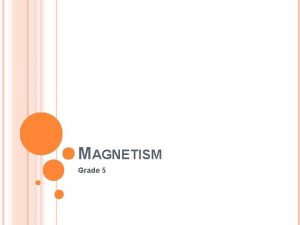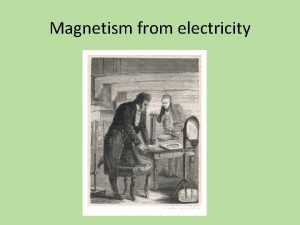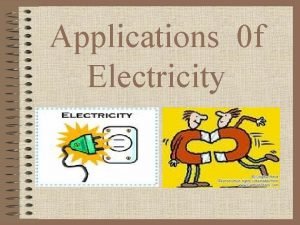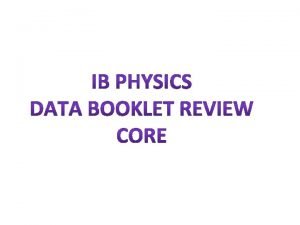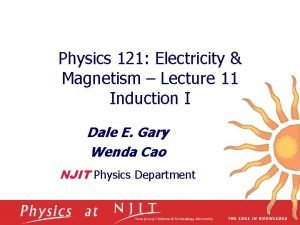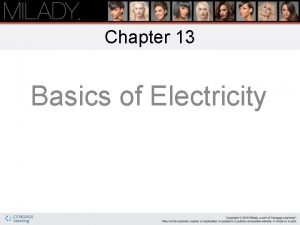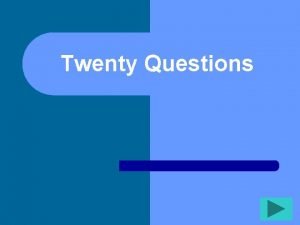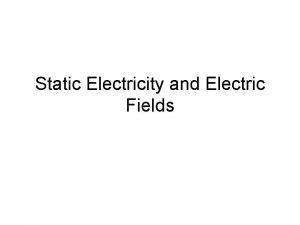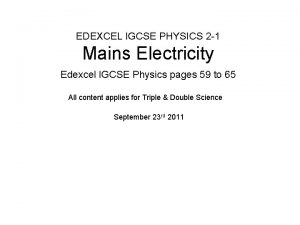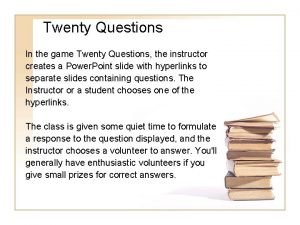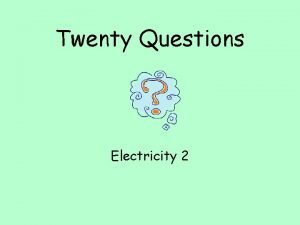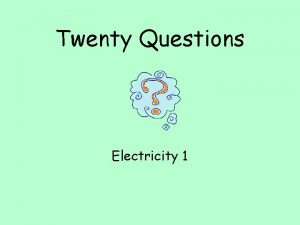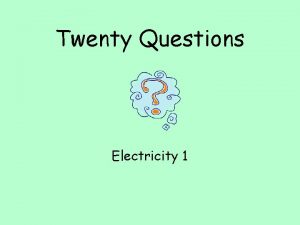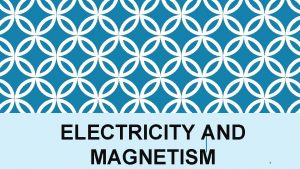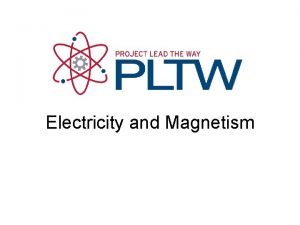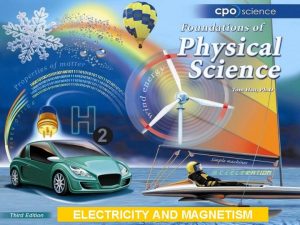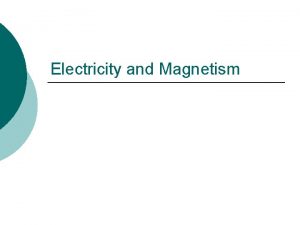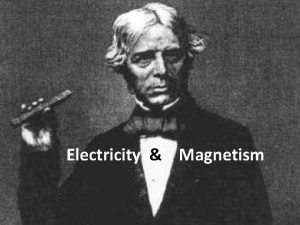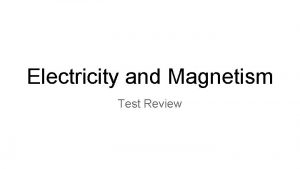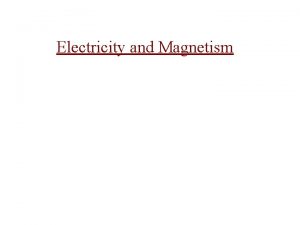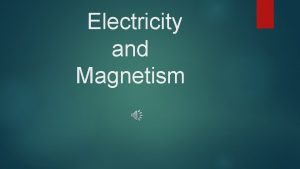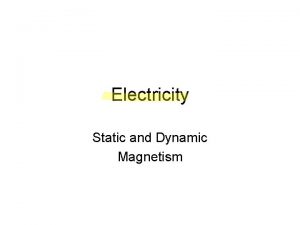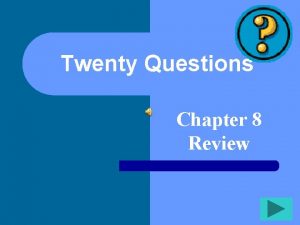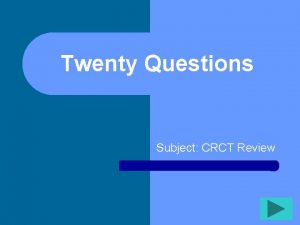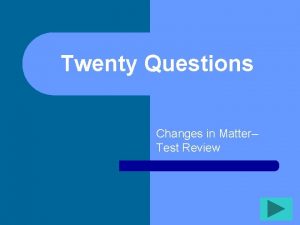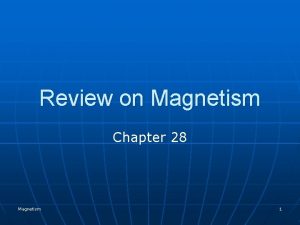Twenty Questions Electricity and Magnetism Test Review Twenty






















- Slides: 22

Twenty Questions Electricity and Magnetism– Test Review

Twenty Questions 1 2 3 4 5 6 7 8 9 10 11 12 13 14 15 16 17 18 19 20

1. A property of matter that causes objects to repel each other is called l An electric charge

2. If you add another light to an electric circuit and all the lights become dimmer, what can you conclude? l It is a series circuit

3. What type of circuit is best to use at home or school and why? l A parallel circuit. If you turn one light off in your school or home, the other lights will not turn off. There is another path for the electricity to flow.

4. If you rub a balloon on a wool sweater, the balloon will stick to the wool. What causes this to happen? l The balloon becomes charged. When the balloon is brought near the wool sweater, it repels similar charges and attracts opposite charges. The balloon is then attracted to the opposite charges.

5. What is a conductor and give 2 examples of a conductor? l A conductor is a type of material through which negative charges move freely. Examples of conductors are most metals, paper clips, foil, etc.

6. What is an insulator and give 2 examples? l An insulator resists the flow of electricity (this means electricity does NOT flow through easily). Examples are nonmetals like wood, glass, plastics, paper, cardboard and foam.

7. Why do electric appliances contain both conductors and insulators? l l They have to have conductors so that current can flow and make the appliance work. They have to have insulators to prevent people from touching the conductors and getting shocked

8. What is an electromagnet? l An electromagnet is a temporary magnet made up of a wire wrapped around a core

9. List 3 facts that you know are true about electromagnets. l l It is a temporary magnet Increasing the number of coils increases the strength It can be turned on and off It is made by wrapping current-carrying wire around an iron core

10. What is the advantage of a magnet that you can turn off and on? l The advantage of an electromagnet is that you can turn it on to pick up objects in one place and turn it off to drop them in another place.

11. What happens when current flows where it isn’t supposed to? l A short circuit occurs.

12. What happens to objects that have the same charge? l They repel or move away from each other

13. What happens to objects if their charges are opposite? l They are attracted to each other

14. The buildup of charges on an object is called l Static electricity

15. You walk across a carpet and feel a shock when you touch the doorknob. What caused this? l You developed a static charge

16. What materials are needed to create an electric circuit? l A battery, wire and a bulb

17. The space in which an electric force acts is called an l Electric field

18. The measure of how much a material opposes the flow of current is called l resistance

19. True of False. Positive charges jump. l False. Only negative charges jump.

20. If two charged objects are attracted to each other, what can you infer about their charges? l They have opposite charges (one object is positively charged and one is negatively charged)
 Physics 102
Physics 102 Ib physics topic 5 questions
Ib physics topic 5 questions Electricity and magnetism lecture notes
Electricity and magnetism lecture notes Electricity and magnetism jeopardy
Electricity and magnetism jeopardy Sph3u electricity and magnetism
Sph3u electricity and magnetism Electromagnet experiment hypothesis
Electromagnet experiment hypothesis Magnetism and electricity
Magnetism and electricity Electricity and magnetism grade 5
Electricity and magnetism grade 5 Electricity and magnetism
Electricity and magnetism Electric fuse and circuit breaker graphic organizer
Electric fuse and circuit breaker graphic organizer Electricity and magnetism
Electricity and magnetism Electricity and magnetism
Electricity and magnetism Electricity and magnetism
Electricity and magnetism Magnetism vocabulary
Magnetism vocabulary Lisa exposes an iron paper clip to a very strong magnet
Lisa exposes an iron paper clip to a very strong magnet Static electricity and current electricity
Static electricity and current electricity Electricity n
Electricity n Chapter 13 basics of electricity
Chapter 13 basics of electricity 20 question game
20 question game Static electricity review
Static electricity review Fuse symbol igcse
Fuse symbol igcse Twenty questions
Twenty questions Subject questions
Subject questions







